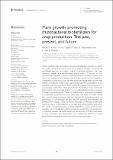| dc.description.abstract | Recent decades have witnessed increased agricultural production to match
the global demand for food fueled by population increase. Conventional
agricultural practices are heavily reliant on artificial fertilizers that have
numerous human and environmental health effects. Cognizant of this,
sustainability researchers and environmentalists have increased their focus on
other crop fertilization mechanisms. Biofertilizers are microbial formulations
constituted of indigenous plant growth-promoting rhizobacteria (PGPR) that
directly or indirectly promote plant growth through the solubilization of soil
nutrients, and the production of plant growth-stimulating hormones and iron-
sequestering metabolites called siderophores. Biofertilizers have continually
been studied, recommended, and even successfully adopted for the production
of many crops in the world. These microbial products hold massive potential
as sustainable crop production tools, especially in the wake of climate change
that is partly fueled by artificial fertilizers. Despite the growing interest in the
technology, its full potential has not yet been achieved and utilization still
seems to be in infancy. There is a need to shed light on the past, current, and
future prospects of biofertilizers to increase their understanding and utility.
This review evaluates the history of PGPR biofertilizers, assesses their present
utilization, and critically advocates their future in sustainable crop production.
It, therefore, updates our understanding of the evolution of PGPR biofertilizers
in crop production. Such information can facilitate the evaluation of their
potential and ultimately pave the way for increased exploitation. | en_US |

